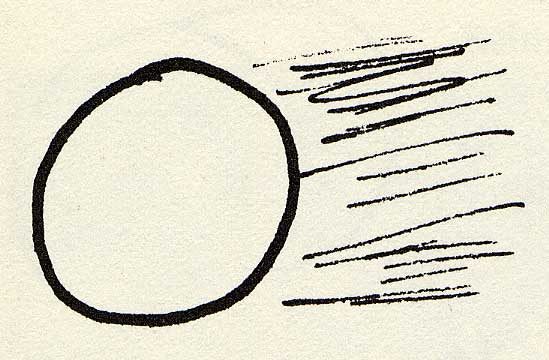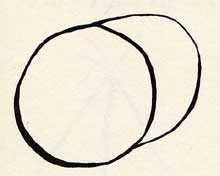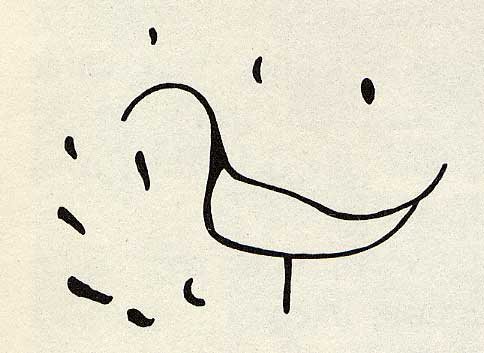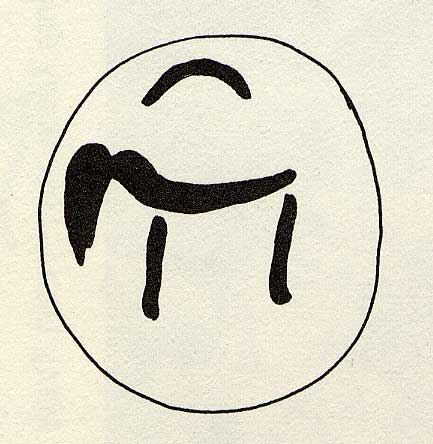|
| |
Narcisse
Blood on story telling
|
| |
| |
| |
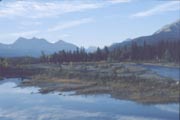 Early morning on the Belly River, Alberta.
Early morning on the Belly River, Alberta.
K. Lugthart photo |
| |
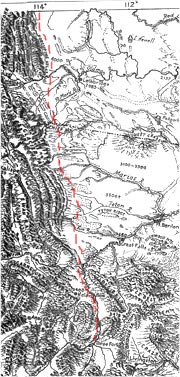 The Old North Trail in Blackfeet country
The Old North Trail in Blackfeet country
Base map adapted from Raisz: 1957 |
| |
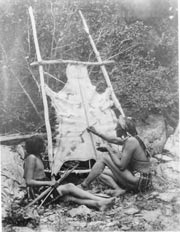
Big Spring illustrates the old way of recording Blackfoot
events and history. Glacier National Park, 1913 (Hungry Wolf: 1989).
Image courtesy of Glacier National Park archives.
|
| |
| |
Darrell
Kipp on Piegan history
|
| |
| Sign language for Piegan (Pikuni):
“Piegan (Indian) – Partially close the right hand; i.e.,
keeping backs of fingers form second joints to knuckles about on line
with back of hand, ball of thumb resting on second joint of index; hold
the hand close to lower part of right cheek, back of hand right, edges
pointing upwards; move the hand, mostly by elbow action, in small circle
parallel to cheek" (Clark 1959:302).
|
|
|
Great Falls > Culture > Since Time Immemorial
|
Narcisse Blood,
coordinator of Kainah Studies at Red Crow Community College in Standoff,
Alberta, speaks about "time immemorial" and the way Blackfeet
people understand their history.
|
|
|
| |
| Oral History |
| |
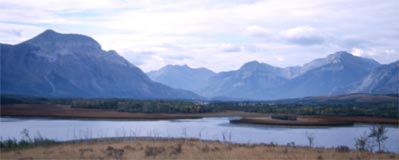 Waterton Lakes, origin of beaver bundle
Waterton Lakes, origin of beaver bundle
K. Lugthart photo Oral traditions include history, stories, and mythology, and
each is different.
History is important to all peoples, and particular methods
are developed by all oral cultures to engage the collective
memory. Oral history is often told in a ceremonial way, with
the history of the people being related through songs, told
in a particular sequence, reflecting their historical relationships.
The words of songs remain the same, even over centuries of
change. By encoding history in songs, the Nitsitapi (Blackfeet)
remember their history from generation to generation.
Stories are always tied to particular people, animals, events,
and places. When Nitsitapi pass a particular place,
they might be reminded of stories of their family and tribe,
of battles with enemies, or of any unusual event that stands
out. These stories are about events that actually happened,
but they are embellished and altered a little with each telling.
In this way, they are different from ceremonial stories of
history.
Myths are another expression of a culture's stories. Although
myths are by definition fiction, they generally hold some
core of fact important to the people. Myths help to convey
the essence of a people, if not the factual history.
Percy Bullchild, a Piegan, explains the importance of oral
history among Blackfeet people:
"We Indians do not have written history like our white friends.
Ours is handed down from generation to generation orally. In this way
we have preserved our Indian history and our legends of the beginning
of life. All history the Native learns by heart, and must pass it on to
the little ones as they grow up. We Natives preserved our history in our
minds and handed it down from generation to generation, from time unknown,
orally. From the time human life began" (Bullchild 1985:2-3).
The oral traditions of the Nitsitapi carry them back to "time
immemorial." How long is that? Anthropologists disagree about
how long Blackfeet people have lived in their homeland. Some
say the Blackfeet have existed in the Upper Missouri country
only a few hundred years; others believe several thousand years
is
more accurate.
The
boundaries
of the territory change through time.
For now, relax. Don't get mired in this argument; instead,
let the stories carry you into a different world where quantification
is less important than experience.
|
|
|
| A Story of the Old North Trail |
| |
A century ago Chief Brings-Down-the-Sun told Walter
McClintock about the Old North Trail:
"There is a well-known trail we call the Old North Trail. It runs
north and south along the Rocky Mountains. No one knows how long it has
been used by the Indians. My father told me it originated in the migration
of a great tribe of Indians from the distant north to the south, and
all the tribes have, ever since, continued to follow in their tracks.
"The Old North Trail is now becoming overgrown with
moss and grass, but it was worn so deeply, by many generations of travelers,
that the travois tracks and horse trail are still plainly visible...
"In many places the white man's roads and towns have obliterated
the Old Trail. It forked where the city of Calgary now stands. The right
fork ran north into the Barren Lands as far as people live. The main
trail ran south along the eastern side of the Rockies, at a uniform distance
from the mountains, keeping clear of the forest and outside of the foothills.
It ran close to where the city of Helena now stands and extended south
into the country inhabited by a people with dark skins and long hair
falling over their faces.
"My father once told me of an expedition from the Blackfeet that
went south by the Old Trail to visit the people with dark skins. Elk Tongue
and his wife, Natoya, were of this expedition, also Arrow Top and Pemmican,
who was a boy of 12 at that time. He died only a few years ago at the
age of 95. They were absent four years. It took them 12 moons of steady
traveling to reach the country of the dark-skinned people, and 18 moons
to come north again. They returned by a longer route through the "High
Trees" or Bitterroot country, where they could travel without danger
of being seen. They feared going along the North Trail because it was
frequented by their enemies, the Crows, Sioux, and Cheyennes.
"I have followed the Old North Trail so often that I know every
mountain, stream, and river far to the south as well as toward the distant
north" (Brings-Down-the-Sun in McClintock 1992: 434-437).
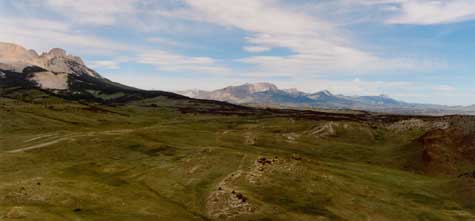
Along the
Rocky Mountain front. |
S. Thompson photo
|
|
| |
| |
| Reckoning Time |
| |
Winter count is a way of reckoning time, a tribal calendar
of history. A long-ago person sat down to record the memorable
events from a round of seasons on a tanned buffalo hide.
"The winter count is an important record.
Not only does it give us a historical record of the Blackfeet
people greater than that previously recorded, but also
an
insight into these events. The memories of those elders
still living have been added to the events as well as those
of past
researchers. It was the feelings of people that started
this record, and they should be carried with it" (Raczka
1979:5).
Original hide drawings for this winter count were made by
five contributors from the North Piegan, or Pikuni. The drawings
include the period from 1764 through 1924. Paul Raczka, with
credit given to elders, compiled the images in a book from
which the following examples are taken. (This winter count
recorded by the Rev. Cannon Haynes in journal form was given
by Bull Plume.)
|
|
1778—The great wind. |
|
1779—When it hailed
in winter. |
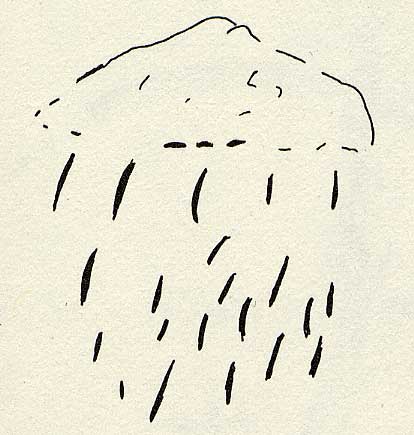 |
|
|
1782—When they took the shield.
The capture of a shield was an important coup. Being both an article
of war and a religious item, the shield was a much sought-after trophy,
especially those of the Crow tribe, which were highly decorated similar
to Blackfoot shields. |
|
1801—When we took
the stars and stripes from the River Indians.
Capturing a flag from the enemy was considered an important act.
Flags were regarded as having power as war medicines. The people
referred to are Pend d'Oreilles, called Niitugta tapi (River
People) in Blackfoot. |
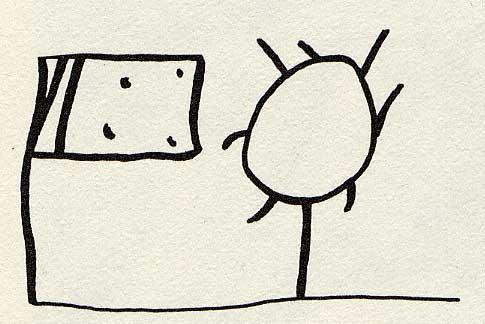 |
|
| Hugh Dempsey, a scholar of Blackfeet
culture, noted the significance,"that an
American flag should be captured by the Piegans
four years before the Lewis and Clark expedition
came west. The area was still considered part
of the Spanish possession, but there were rumors
and indications from David Thompson that Americans
had penetrated the area even prior to Lewis and
Clark." (Dempsey: personal communication
to Raczka, 1978) |
|
|
1805—When the crows died. This refers
to the bird, not the tribe.
|
|
1806—Many foolish
children were killed. [Children had wandered
away from the camp and
drowned.] |
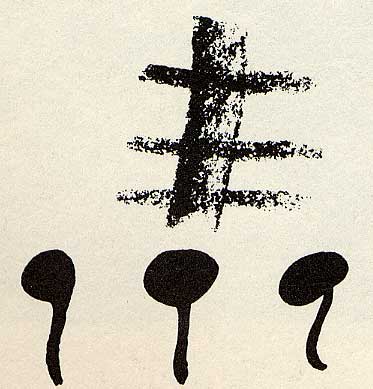 |
|
|
1808—Getting paint and taking captive
(near Turtle Mountain, by Crow Indians).
There is a location for getting earth paint on the Castle River
near
Turtle Mountain.
(Raczka: 1979) |
|
Source:
Raczka, P. M. Winter Count: A history of
the Blackfoot people. Calgary: Friesen
Printers for Oldman River Culture Center, 1979.(from
original hide drawings) |
|
|
| |
| Archaeological Evidence of the Blackfeet |
| |
Archaeological evidence indicates that the
Blackfeet people have lived in the region of the Northwestern
Plains for at least 6,000 years.
Stylized stone projectile points are the key
indicators of ancestral Blackfeet sites. Their territory was
not constant through these millennia. It changed within the
region depending on shifting food resources and relationships
with neighbors.
One significant campsite, located alongside an
oxbow meander of the Sun River near the Great Falls, was used
by Blackfeet people off and on for thousands of years. Meriwether
Lewis came close to this site when he was exploring the area
during the summer of 1805.
Although the Piegan, Kainah, and Siksika bands were
spread over a large territory, even larger than the Blackfeet homeland
of historic times, they centered around the Sand Hills of southwestern
Saskatchewan. There they buried their loved ones. Blackfeet people
still talk of their spirits' returning to the Sand Hills after
death. (Greiser, 1986, 1994; Reeves, 1969). |
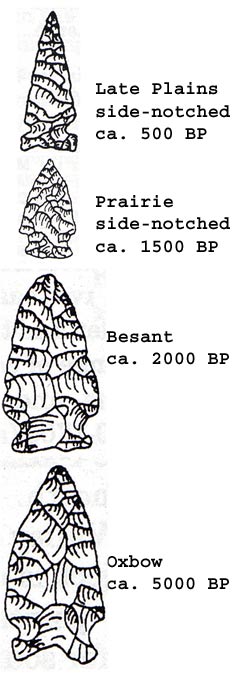
Image courtesy of S. Thompson. |
|
| |
Background ©Apiisoomahka
Wm. Singer III, 1993;
used with permission from Red Crow College |
|
|
|















